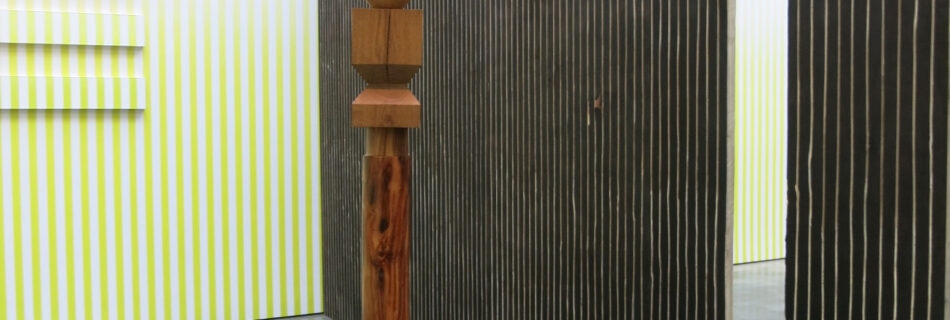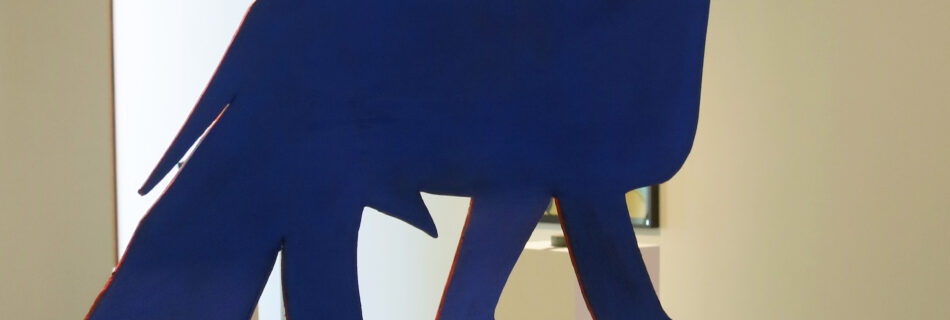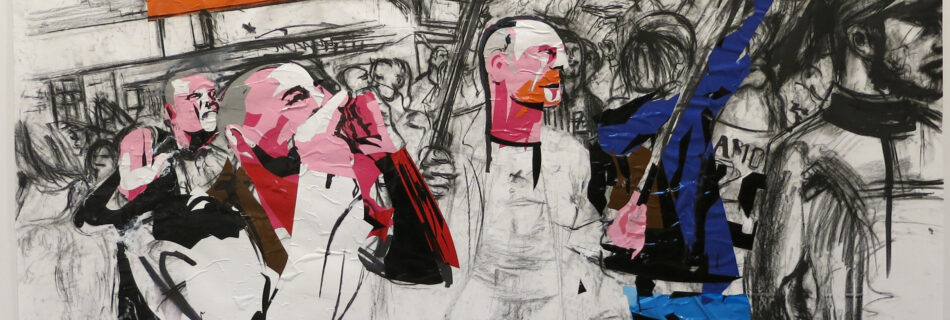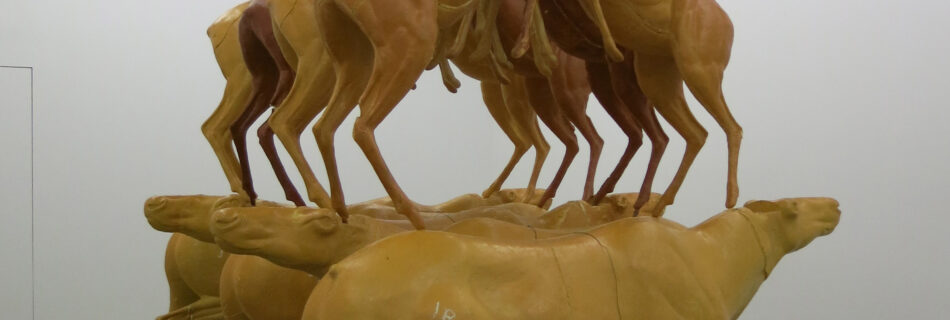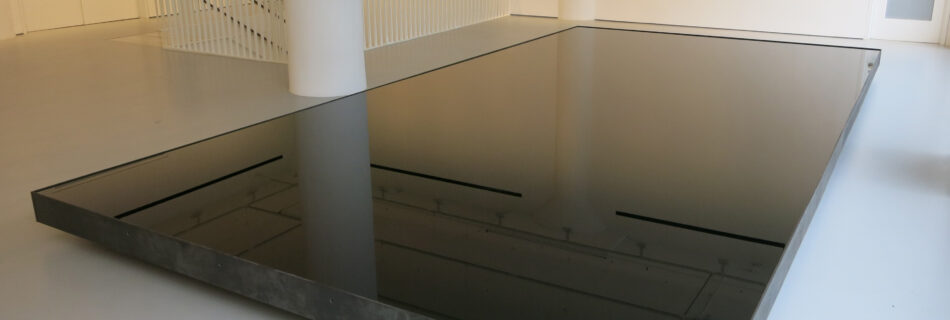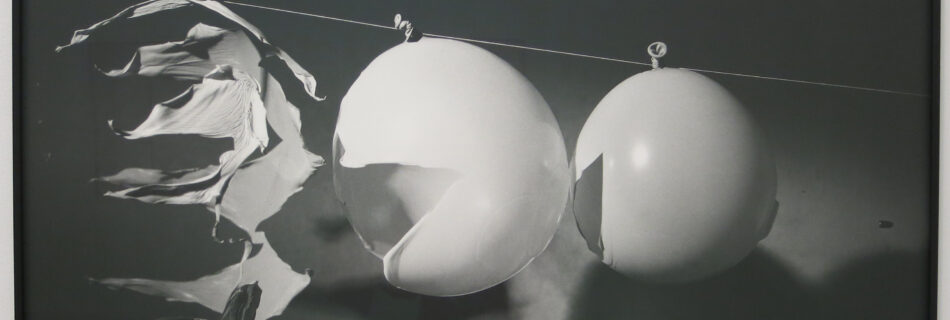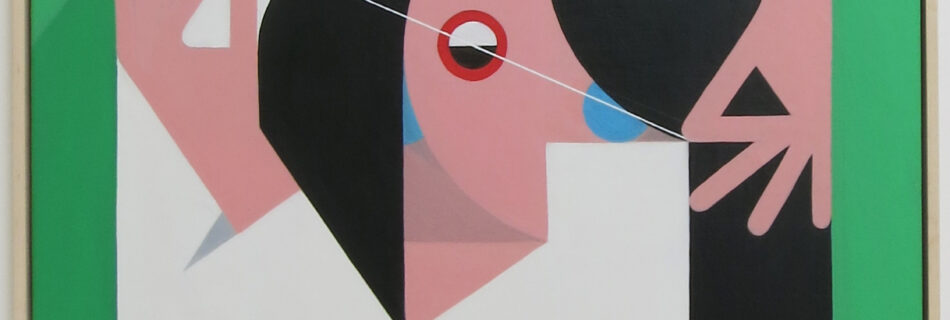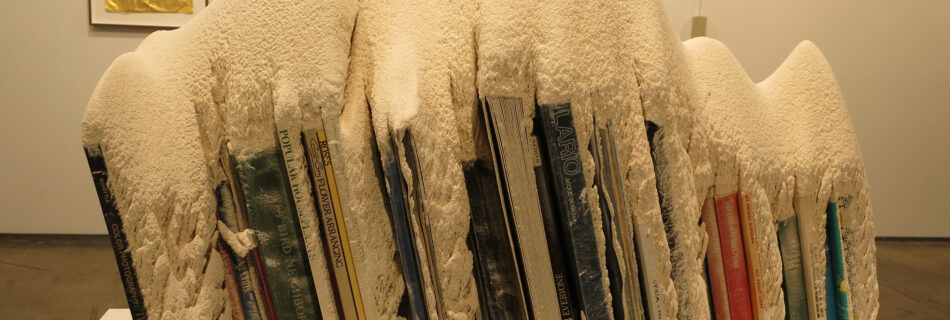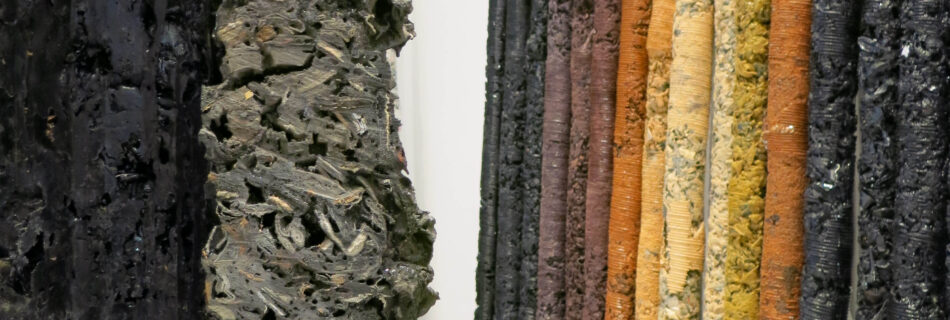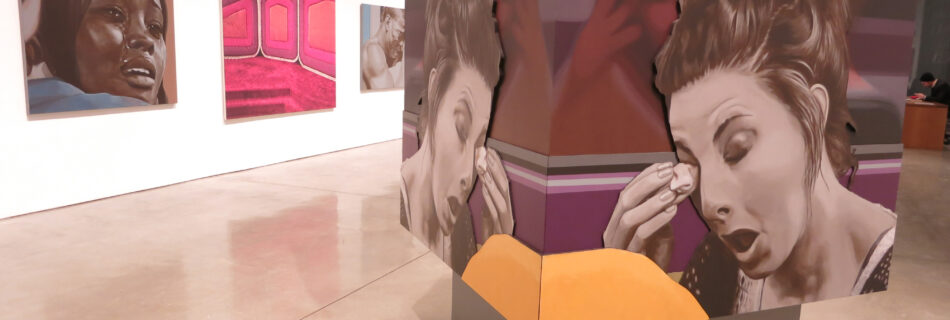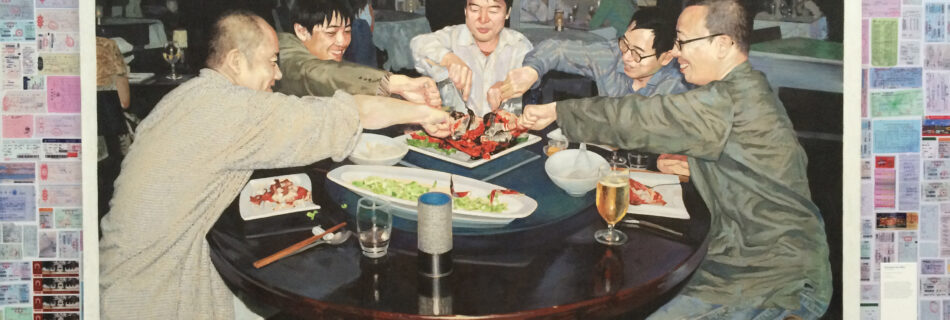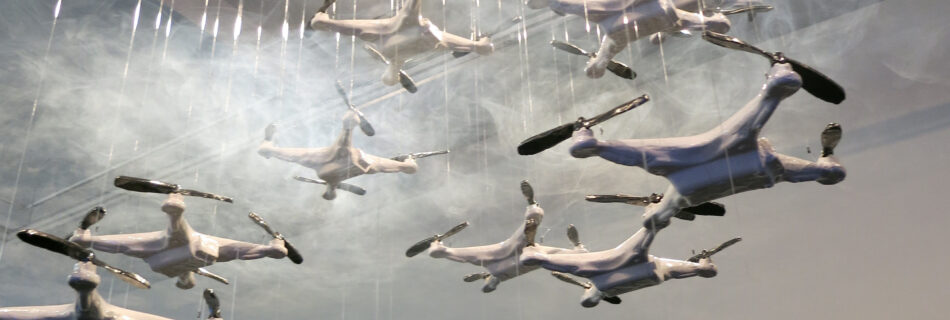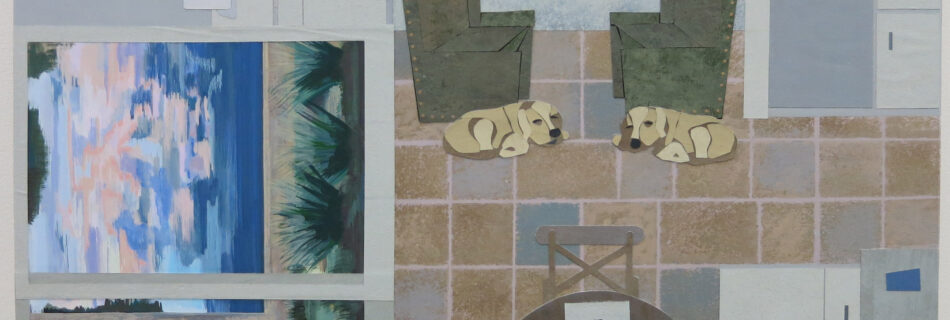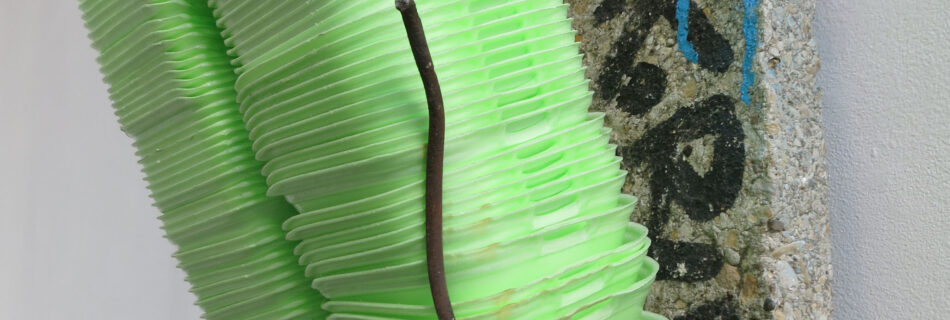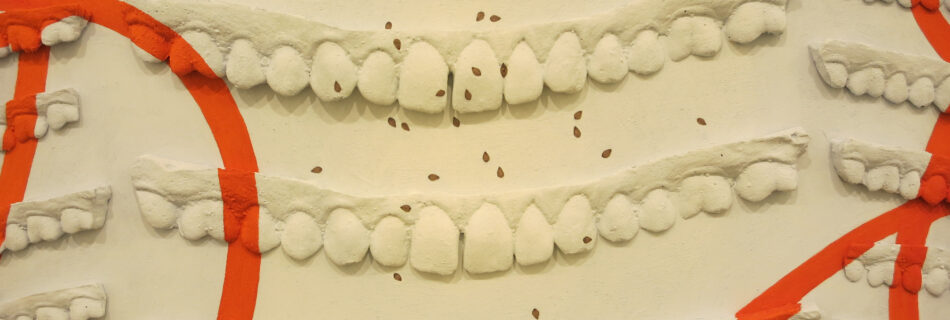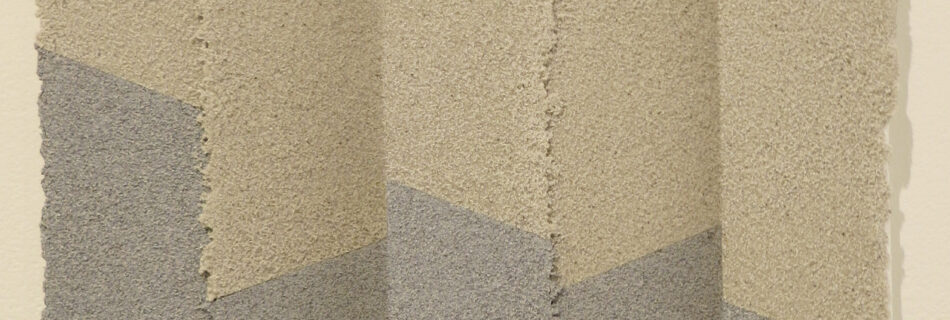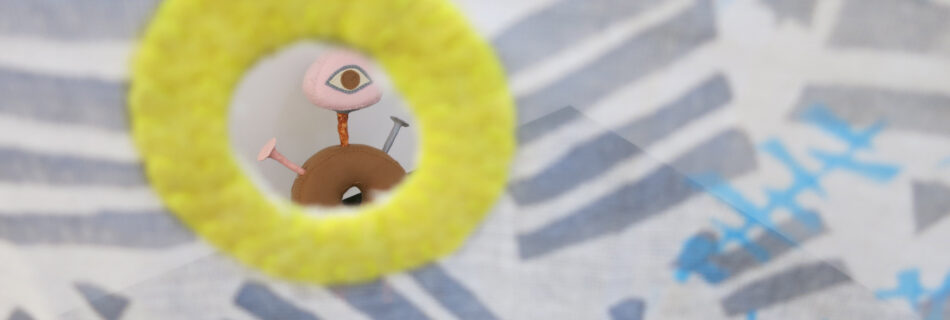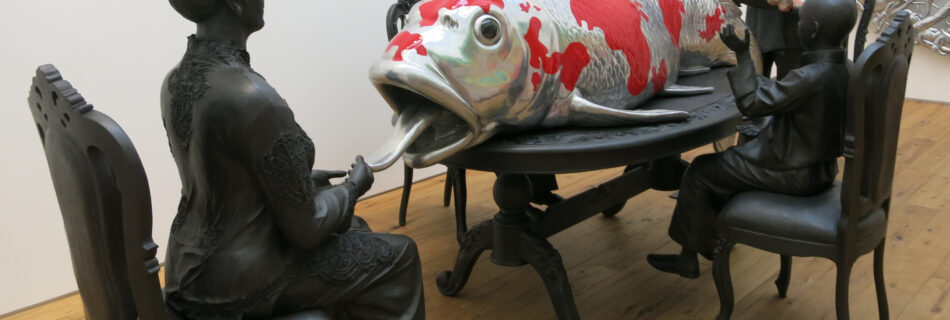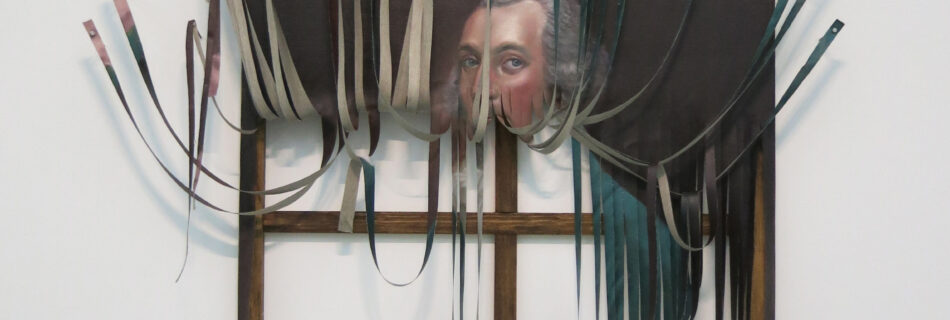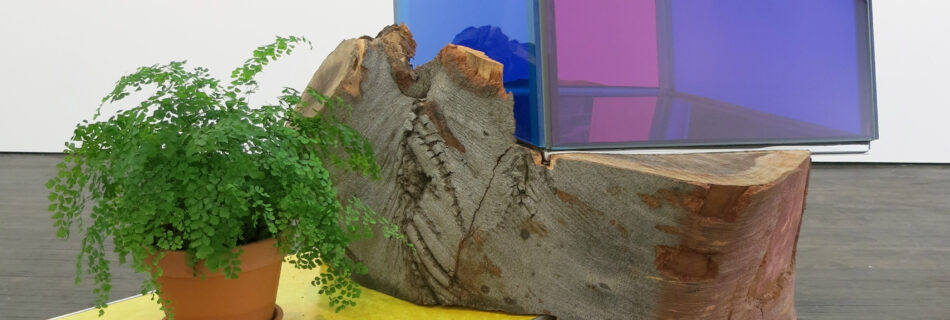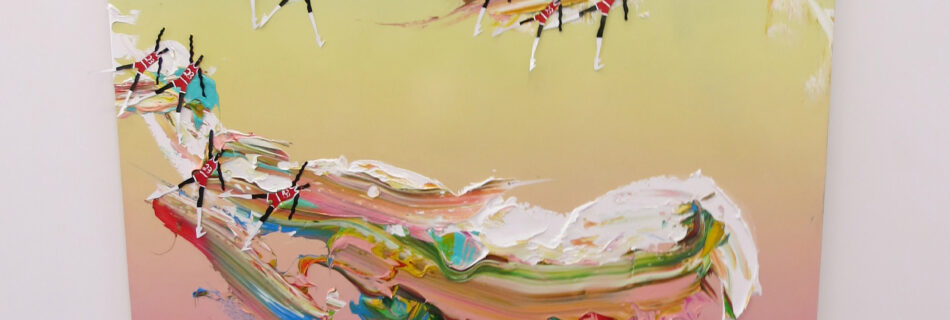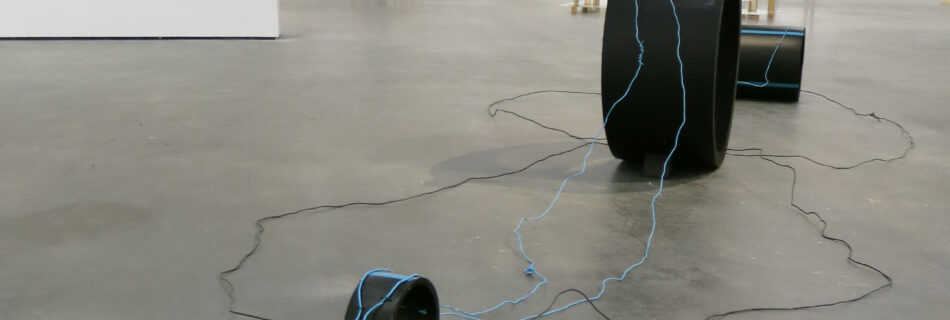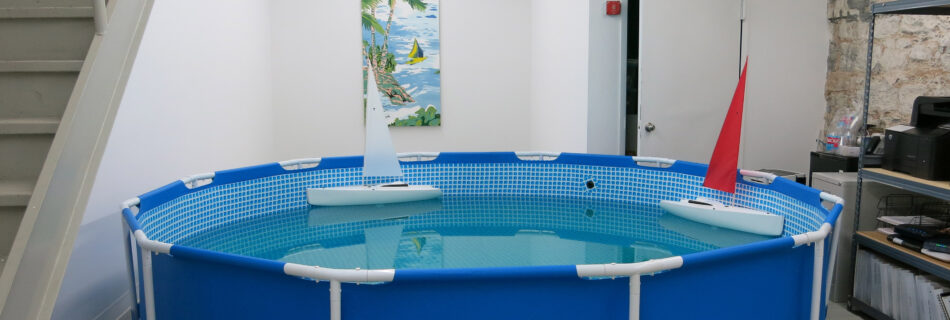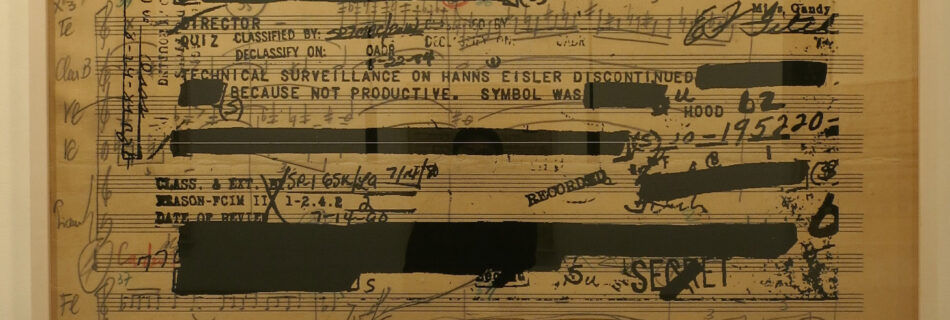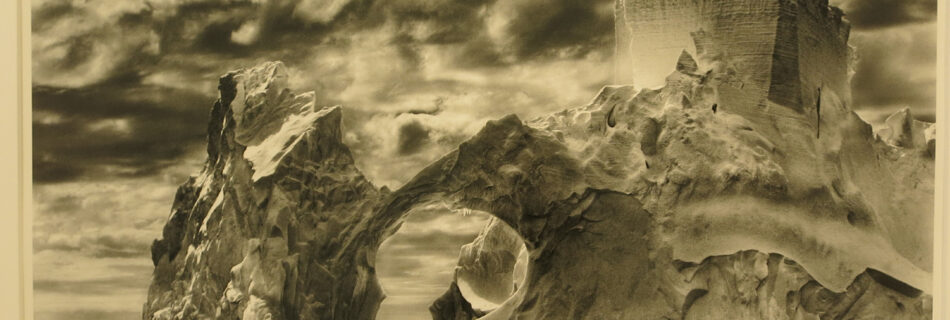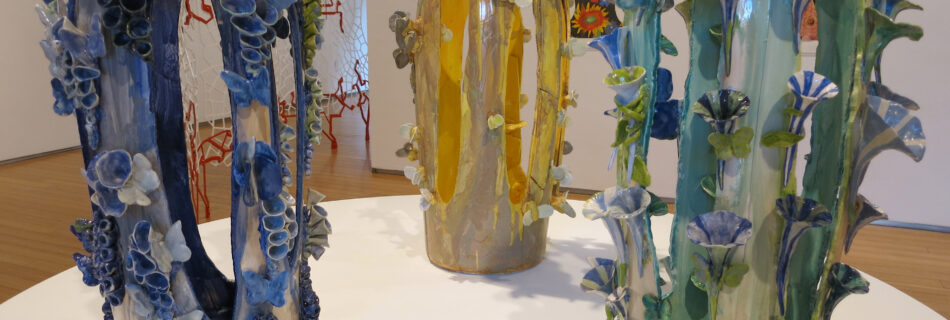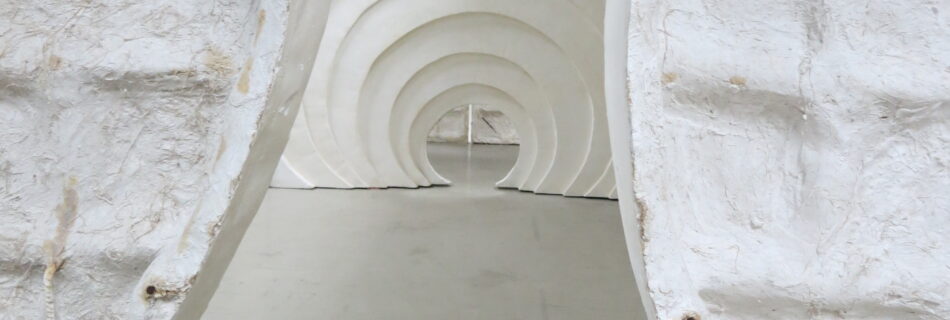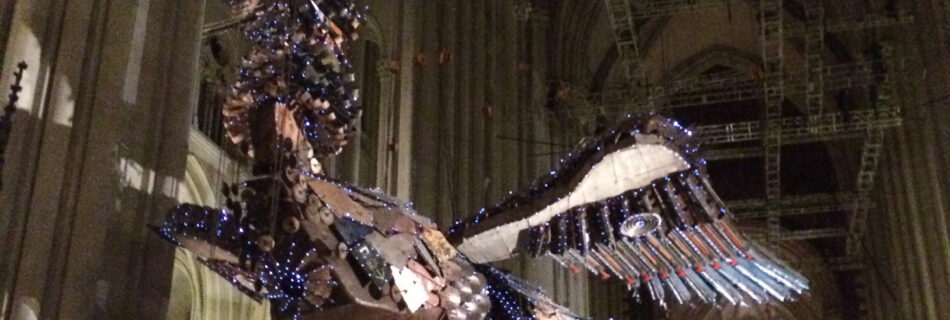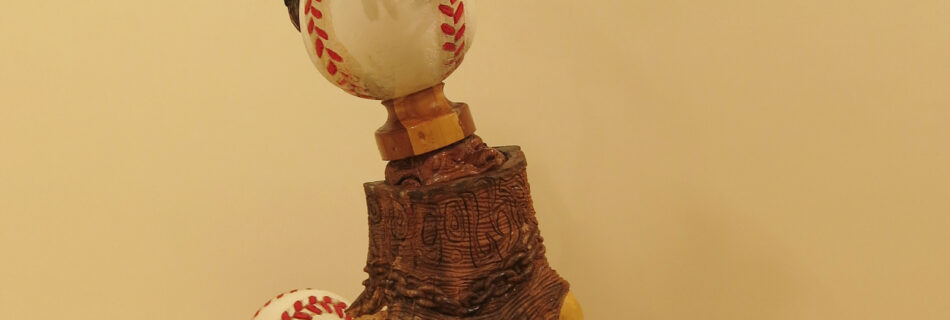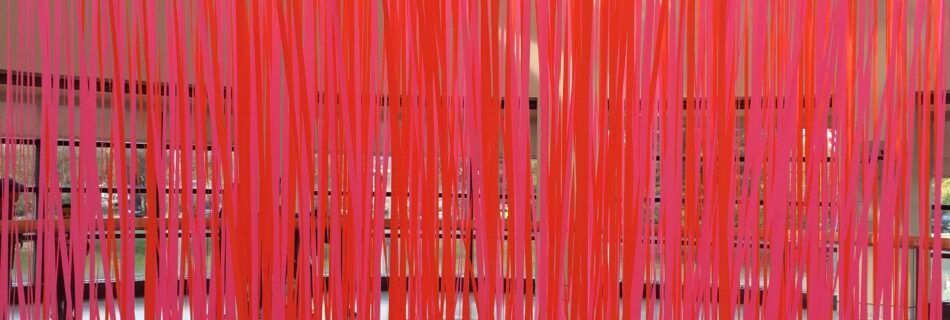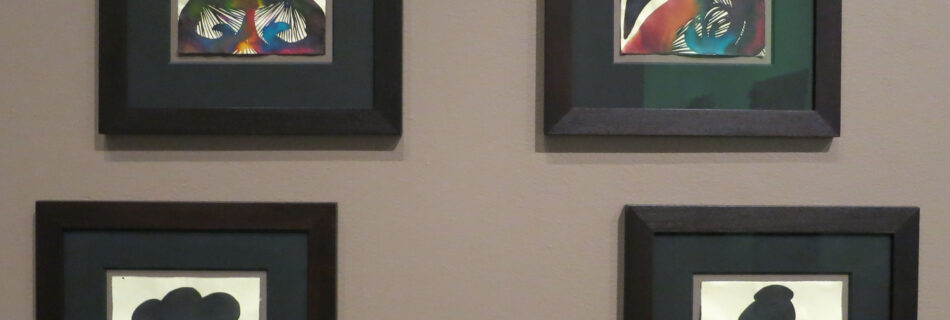Claudia Comte, installation view of ‘No Melon No Lemon’ at Barbara Gladstone Gallery, Feb 2015.![]()
Alexander Calder at Paul Kasmin Gallery
Though one of Alexander Calder’s better-known mobiles hangs above, it’s this sheet metal llama that catches the eye at Paul Kasmin Gallery in Chelsea. Included in an exhibition which partially recreates a groundbreaking show of New York art curated by Henry Geldzahler in 1969, its flat monochrome links it to surrounding minimal abstractions by Warhol, Noland, Flavin and more. (Through March 8th).
Alexander Calder, Moon Faced Llama (blue and red), painted sheet metal, 1971.![]()
Erik van Lieshout at Anton Kern Gallery
Dutch artist Erik Van Lieshout recreates newspaper protests of demonstrations between Dutch-nationalists and Muslim factions in Holland in vinyl and charcoal at Anton Kern Gallery. A provocateur who The Guardian recently called ‘The Ali G of Art’ for his disregard for social convention, Van Lieshout’s drawings impressively channel the aggression and adrenaline of street confrontation. (In Chelsea through Feb 28th).
Erik Van Lieshout, Untitled, charcoal, acrylic and vinyl on paper, 59 1/8 x 107 7/8 inches, 2014.![]()
Bruce Nauman at Gagosian Gallery
Seventeen taxidermy molds of foxes, deer and caribou by iconic conceptual artist Bruce Nauman are poised like an acrobatic troupe but are more creepy than entertaining. Nauman ups the discomfort by keeping them hairless to suggest that they’ve experienced an unnamed brutality. (At Gagosian Gallery’s 821 Park Ave location through Feb 21st).
Bruce Nauman, Animal Pyramid, polyurethane foam, iron, wood, and wire, 144 x 84 x 96 inches, 1989.
![]()
Noriyuki Haraguchi at Fergus McCaffrey Gallery
This gorgeous reflecting pool by Japanese artist Noriyuki Haraguchi – an update on his iconic versions from the 70s – is the picture of serenity in the pristine upstairs gallery of Chelsea’s Fergus McCaffrey Gallery. Contrary to appearances, though, the pool is full of spent machine oil, a symbol of our attraction to a natural resource with not-so-beautiful byproducts. (Through Feb 21st).
Noriyuki Haraguchi, Oil Pool, steel, spent motor oil, 24 x 12 feet.
Harold Edgerton at Sikkema Jenkins & Co
A cup shatters, a golfer swings and a bullet pierces balloons in photos by late scientist Harold Edgerton, who made time freeze with the aid of an electric strobescope. This image of three bursting balloons demonstrates three stages of destruction with arresting beauty. (At Sikkema Jenkins & Co through March 7th).
Harold Edgerton, Bullet Through Three Balloons, gelatin silver print, 30 x 48 inches, 1959, printed 1989.![]()
Leonhard Hurzlmeier in ‘Proper Nouns’ at Rachel Uffner Gallery
This mildly racy painting by young German artist Leonhard Hurzlmeier of a dentist getting ready in the morning gives pause for thought – is she demonstrating extreme skill or incredible awkwardness? (At Rachel Uffner Gallery through Feb 22nd).
Leonhard Hurzlmeier, Zahnarztin bei der Morgantoilette (Dentist Getting Ready), oil on canvas, 38.4 x 27.2 inches, 2013/14.![]()
Jonathan Callan in ‘The Suspended Line’ at Josee Bienvenu Gallery
British artist Jonathan Callan’s serene white mountain range encases a selection of books on nature (including ‘All About Lions,’ and ‘Bird Neighbors’) in plaster, suppressing knowledge of nature in favor of imitating it. (In ‘The Suspended Line’ at Josee Bienvenu Gallery in Chelsea through Feb 28th).
Jonathan Callan, Range, paper and plaster, 33.85 x 21.25inches, 2012.![]()
Helmut Lang at Sperone Westwater
For his biggest New York solo show to date at Sperone Westwater on the Lower East Side, fashion designer turned artist Helmut Lang continues to work with industrially shredded garments from his archive, which were accidently destroyed by fire. Strange creatures, birch trees and industrial processes come to mind in these mediated organic forms. (Through Feb 21st).
Helmut Lang, installation view of Untitled sculptures in resin, pigment and mixed media, 2010-2013 or 2012–2013.
John Miller at Mary Boone Gallery
Game show contestants and reality TV personalities are the subject of John Miller’s paintings and this sculpture at Mary Boone Gallery in Chelsea. Moments of supposedly ‘real’ emotion accompany paintings of empty, dramatically tacky game stages, conjuring a bizarre world of fakeness. (Through Feb 28th).
John Miller, Public Display, 68 x 58 x 58 inches, acrylic/wood, formica, 2013.![]()
Nolan Simon at 47 Canal
Pulling source images from the web, young Brooklyn artist Nolan Simon copies them to canvas, framing each one with painted, trompe l’oeil masking tape like an analogue version of open windows on a computer screen. While the technique doesn’t radically update collage, Simon has an eye for intriguingly odd juxtapositions. (At 47 Canal on the Lower East Side through Feb 15th).
Nolan Simon, Commonwealth, oil and acrylic on canvas, 48 x 36 inches.
Polit-Sheer-Form Office at Queens Museum
Chinese art group ‘Polit-Sheer-Form Office’ asks what that collectivity means today in China in light of trends toward individualism and consumption. Here, in a painting at their Queens Museum show, they riff on Cultural Revolution propaganda posters that featured happy workers gathering around Mao, substituting themselves cheerfully tucking into a communal dish. (Through March 18th).
Polit-Sheer-Form Office, Polit-Sheer-Form-16, oil on canvas, 2007.![]()
KATSU at The Hole NYC
Brooklyn-based artist KATSU is known for semi-abstract paintings created by drone; here at The Hole, a cluster of ceramic drone sculptures periodically disappears in a cloud of vape-generated smoke. (On the Lower East Side through Feb 22nd).
KATSU, Ceramic drone swarm, ceramic stoneware, 15 x 15 x 3 inches, 2014-2015.![]()
Mike Nelson at 303 Gallery
How would life continue after an apocalypse? British artist Mike Nelson’s latest show at Chelsea’s 303 Gallery imagines a scenario in which a group of survivors on the North Sea coast build sculpture from washed up trash to recreate what they haltingly remember. This serpent, tattered flags and various totems speak to an unstoppable urge to establish a bulkhead and mediate the unknown. (Through Feb 21st).
Mike Nelson, detail from the installation ‘Gang of Seven,’ found materials collected from the North West Pacific Coast (feathers, tires, rocks, driftwood, Styrofoam, metal rods and chains, pylons, clothing), dimensions variable, 2013.![]()
Ann Toebbe at Monya Rowe
This tranquil domestic interior is too cute, with its matching mugs by the fire, two dogs, two laptops and beautiful beach view. But the scene might not be as cozy as it looks – Ann Toebbe’s latest painted, handcut paper collages depict domestic interiors from friends’ and family members’ past marriages. (At Monya Rowe Gallery on the LES through Feb 22nd).
Ann Toebbe, Remarried, gouache, acrylic and cut paper on panel, 16 x 20 inches, 2015.![]()
Jennifer Nocon at Tracy Williams Ltd
Nature inspires LA-based artist Jennifer Nocon’s gorgeous ceramic and felt installation Sky Diamond, the centerpiece of her solo show at Chelsea’s Tracy Williams, Ltd. Stylized cloud illustrations on ceramic cloud shapes give forth blood-red, kelp-like jets of rain, making for a fascinating and slightly disturbing phenomenon. (Through Feb 14th).
Jennifer Nocon, Sky Diamonds, hand-dyed wool felt, ceramic clay, glaze, gold thread, 100 x 316 inches, 2014.![]()
Anita Molinero in ‘Derive(s)’ at Bryce Wolkowitz Gallery
French artist Anita Molinero is known for destroying vibrantly colored, plastic consumer goods by melting them. Here, pale green Styrofoam trays remain intact but pierced, supported by cradling metal arms and a backed by a chunk of concrete. (At Bryce Wolkowitz Gallery through Feb 14th).
Anita Molinero, Untitled, 16 ½ x 12 ½ x 15 inches, 2014.![]()
Lucy Kim at Lisa Cooley
Over one hundred dental casts of the same smile create a grid in this slightly creepy, subtly funny 3-D painting by Massachusetts-based painter Lucy Kim at Lisa Cooley Gallery on the Lower East Side. With cartoon-like swirls of red curls and sesame seeds connoting freckles, this character – with her super abundance of toothy grins – charms and repulses at the same time. (Through Feb 15th).
Lucy Kim, detail of Tomorrow, Tomorrow (Leeza Smiles), oil paint, acrylic paint, urethane resin, polyurethane glue on dibond panel, 36 x 45 inches, 2014.![]()
Suzanne Song in ‘January’ at Mixed Greens
Optical illusion is Suzanne Song’s stock-in-trade, whether she’s painting a false corner into a gallery corner or making an acrylic on canvas painting that looks like the happy result of a mid-century minimalist casually making art on the beach. The illusion of folding, layering and a gritty surface and keep the eye moving this piece at Chelsea’s Mixed Greens. (Through Feb 14th).
Suzanne Song, Centerfold, acrylic on canvas, 14 x 11 inches, 2014.![]()
Jonathan Baldock Sculpture at Nicelle Beauchene
Behind a pleasantly printed pastel sheet strung across one corner of the gallery, a quirky little donut-bodied character by young British artist Jonathan Baldock instructs (according to the title) ‘How to Open Your Third Eye.’ (At Nicelle Beauchene Gallery on the LES through Feb 8th).
Jonathan Baldock, Screen with Peep-holes, muslin, acrylic, thread, 105 ½ x 141 ½ inches, 2014. And Jonathan Baldock, How to Open Your Third Eye, felt, wadding, silk thread, ceramic polymer, 23 ½ x 12 x 6 inches, 2015.![]()
Tal R, Jacobe Smoking at Cheim & Read
Copenhagen-based painter Tal R’s latest solo show at Chelsea’s Cheim & Read features lounging female acquaintances rendered in his characteristic toned-down vibrant palette. Abstract sculpture, multiple patterned rugs, and a purple-haired model in this picture suggest an update on Matisse’s exoticism. (Through Feb 14th).
Tal R, Jacobe Smoking, pigment and rabbit skin glue on canvas, 48 x 34 5/8 inches, 2013.![]()
Entang Wiharso at Marc Straus
As far as family portraits go, this one is by far one of the strangest I’ve seen, as a matron with a knife in her hair touches a carp’s tongue and father stands by cradling a skull while two boys look on. Wiharso has explained that in his work, tables are meant as meeting places and sites for negotiation; as such, this family has a lot to work through. (At Marc Straus on the Lower East Side through Feb 8th).
Entang Wiharso, Inheritance, graphite, resin, color pigment, thread, steel, life-size installation, 2014.![]()
Titus Kaphar at Jack Shainman Gallery
New York artist Titus Kaphar disrupts each of his works, cutting figures out of a canvas to consider the impact of absence, whiting out and redrawing figures or peeling back a layer of canvas to literally reveal a back story. Here, a colonial-era man’s portrait is shredded and stretched to shatter any illusion of a tidy personal narrative. (At Chelsea’s Jack Shainman Gallery through Feb 21st).
Titus Kaphar, Stripes, oil on canvas and nails, 59 ½ x 51 x 1 ½ inches, 2014.
![]()
Sarah Braman in ‘Zabriskie Point’ at Jack Hanley Gallery
Man-made objects and nature come together in surprising ways in this sculpture by New York artist Sarah Braman, as a cube recalling modernist architecture perches atop a massive tree stump (nature sacrificed?). A table and houseplant complete this pretty assemblage which points to the domestic realm as a place where nature is potted for pleasure and convenience. (At Jack Hanley Gallery on the Lower East Side through Feb 8th).
Sarah Braman, Underthunk, welded steel, color gels, glass, tree stump, house plant, aluminum, 65 x 35 x 70in, 2014.![]()
Robert Kushner at DC Moore
Robert Kushner’s latest paintings at DC Moore include this gorgeous rendition of a fern, which blends modernist stripes with Japanese-style gold leafing and complex surface texture in a radiant homage to the natural world. (In Chelsea through Feb 14th).
Robert Kushner, Fern, oil, acrylic and gold leaf on linen, 84 x 60 inches, 2014.![]()
Devin Troy Strother at Marlborough Chelsea
It could be the outer space carpet or the thickly painted pastel-colored smiley face on this painting, but it’s hard to be sober in young LA artist Devin Troy Strothers’ latest solo show at Marlborough Chelsea. Here, basketball literally becomes an art form as little players in mid-dunk decorate the eyes and smile of this goofily-grinning abstract painting. (Through Feb 14th).
Devin Troy Strother, Devin Troy Strother x Rob Pruitt x Cory Arcangel x Walead Beshty x A Sad Face x 10 Michael Jordans, ink jet, air brush, acrylic, oil varnish, painted paper on birch panel, 84 x 60 x 2 inches, 2014.
Al Taylor Sculpture at David Zwirner
Using telephone cable and pipes from local construction sites, Al Taylor created this sculpture on site for an exhibition in Denmark in 1997. Here, the cables read like colorful and jittery lines connecting solid objects whose shapes suggest the entire piece might literally begin to move. (At David Zwirner Gallery, 20th Street location through Feb 14th.)
Al Taylor, Full Gospel Neckless (Dog Act), P.E. plastic tubes, rubber wheel chocks and plastic-coated copper telephone cable, 27 ½ x 206 x 64 inches, 1997.![]()
Greer Patterson at Marlborough Gallery Broome Street
Greer Patterson’s new tropical landscape paintings at Marlborough Gallery were inspired by scenes from his Hawaiian shirts; the pool with two remote-controlled boats installed in the basement also uses materials at hand to create pleasant place. It’s not the Central Park boat pond, but on a cold January day, it’s nice to dream. (At Marlborough Gallery, Broome Street, through Feb 15th).
Greer Patterson, Partners in Crime, round metal frame pool with remote controlled boats, 30 x 144 x 144 inches, 2014.![]()
Zachary Leener in ‘The Curve’ at Wallspace
Young LA-based artist Zachary Leener’s quirky abstract ceramic sculptures stand out in two New York group shows this month. At Wallspace Gallery in Chelsea, this beautifully glazed piece evokes the human body, truncated phallic forms and lab equipment. (Also at Rachel Uffner Gallery on the LES. At Wallspace through Feb 14th).
Zachary Leener, glazed ceramic, 14 x 12 x 13 inches, 2014.![]()
Jiri Georg Dokoupil at Paul Kasmin Gallery
Soap bubbles – a delight to both the young and the old – are the basis for Berlin-based artist Jiri George Dokoupil’s work on show at Paul Kasmin Gallery. Since the early 90s, the artist has experimented with various combinations of soap, pigment and other materials to create permanent traces of ephemeral beauty. (through Feb 7th).
Jiri Georg Dokoupil, Untitled, soap-lye and pigments on canvas, 98 ½ x 118 1/8 inches, 2014.
Anya Gallaccio at Lehman Maupin Gallery
In the past, British artist Anya Gallaccio has left red gerbera flowers to rot, covered walls with chocolate and placed a 32-ton block of ice to melt in a disused pump station, all as part of an art practice based on experimentation and manipulation of natural materials. In these stone pieces, she considers longer spaces of time – the effect of heat and pressure on minerals over the millenia. (At Lehman Maupin Gallery on the LES through Feb 15th.)
Anya Gallaccio, installation view at Lehman Maupin Gallery, (foreground) Lay my head, lavignes (stripes), mount ashen, texas cream, black granite and green chirt, 51 x 56 x 48 inches, 2014.
Susan Philipsz at Tanya Bonakdar Gallery
In British sound artist Susan Philipsz’s new installation at Chelsea’s Tanya Bonakdar Gallery, boldly redacted FBI documents overlay quickly penciled archival scores by composer Hanns Eisler. An LA-based refugee from Nazi Germany, his branding as a communist prevented his scores from accompanying Charlie Chaplin’s ‘The Circus.’ Here, wall-mounted documents like this one are joined by a 12-channel sound installation that plays selections from his film compositions, daring viewers to find a note of sedition. (Through Feb 14th).
Susan Philipsz, from the Part File Score series, digital print and silk screen print on canvas, 74 ½ x 59 x 1 2/3 inches, 2014.![]()
Tyson Reeder at Canada
A 70s style motorcycle merges with a camouflage carpet in front of a geometric patterned wall in Tyson Reeder’s ‘Chopper,’ one of several new canvases that look like a teenager’s careful drawing of an object or place that’s desirable but out of reach. (At Canada on the Lower East Side through Feb 15th).
Tyson Reeder, Chopper, mixed media on paper on canvas, 52 x 71 inches, 2014.![]()
Elaine Reichek Installation at Zach Feuer
Elaine Reicheck updates Henri Matisse’s Blue Nude as part of her Swatches series, for which she Googles canonical art historical works, modifies their color and size, and renders them via a digital sewing machine on small fabric swatches. Presented as one of hundreds, an iconic artwork turns cute, neutralized by its size and the suggestion that it is just one of many. (At Zach Feuer Gallery through Feb 7th).
Elaine Reicheck, installation view of Swatches at Zach Feuer Gallery, Jan 2015.![]()
Michael McKenna at Robert Mann Gallery
Outdoor scenes including a hot-air balloon over a Mexican pyramid and a lone, wind-gnarled tree by a lake in Japan have inspired British American photographer Michael Kenna’s serenely beautiful black and white images, now on view at Chelsea’s Robert Mann Gallery. Here, a jet of water shoots into the air, merging water and clouds in a mediated ‘equivalent’ worthy of Stieglitz. (In Chelsea at Robert Mann through January 31st).
Michael Kenna, Jet d’Eau, Geneva, 9.5 x 6.5 inches, 2012.
Yael Bartana, Inferno at Petzel Gallery
In 22 minutes of rich visuals, Israeli artist Yael Bartana inaugurates and destroys a replica Solomon’s Temple in her captivating film ‘Inferno.’ Inspired by a version of the temple finished last summer in Sao Paulo by a religious group (built with stones imported from Israel) Bartana’s film compresses a sequence of emotions – exhilaration to horror to indifference at a distant memory – at a dizzying rate. (At Petzel Gallery through Feb 14th).
Yael Bartana, still from ‘Inferno,’ Alexa camera transferred onto HD, 22 minutes, 2013.![]()
The Memphis Group at Koenig & Clinton
The postmodern Italian design collective The Memphis Group flaunted ‘good taste’ in the 80s with their anti-modernist designs and materials that included molded plastics and laminates. Now the public can’t get enough, as evidenced by an irrepressibly upbeat show of furniture and design at Chelsea’s Koenig and Clinton Gallery. (Through Jan 31st).
Installation view of The Memphis Group at Koenig and Clinton, Jan 2015. Featuring Michele De Lucchi’s ‘Lido’ couch and ‘Polar’ end tables and Ettore Sottsass’s ‘Treetops’ lamp and ‘Park Lane’ coffee table.
Reinier Gerritsen at Julie Saul Gallery
On the subway platform one day, Dutch photographer Reinier Gerritsen noticed a serendipitous arrangement in red in the bag, sweater and lips of three women reading on the 6 train. From this initial flash of inspiration, Gerritsen began his a series of photo collages, bringing together book readers in single compositions that memorialize the printed tome. (On view at Chelsea’s Julie Saul Gallery through Feb 7th).
Reinier Gerritsen, One Hundred Years of Solitude, pigment print, 40 ½ x 70 ¾ , 2013.
![]()
Mamma Andersson at David Zwirner Gallery
Dolls, puppets, and dancers populate Swedish artist Mamma Andersson’s new, theatrically lit show at Chelsea’s David Zwirner Gallery. This towering character has a bonnet and a complexion to match the porcelain on her side cabinet. (Through Feb 14th).
Mamma Andersson, installation view of ‘Behind the Curtain,’ at David Zwirner Gallery, January, 2015.![]()
Sebastiao Salgado at Yancey Richardson Gallery
Ocean waves smoothed the base of this iceberg while wind erosion and detached ice carved the top into this majestic, castle-like form. It’s one of the many stunning images from Sebastiao Salgado’s latest ‘Genesis’ series – for which the artist travelled the world photographing landscapes untouched by modernization – currently on view at Chelsea’s Yancey Richardson Gallery. (Through Jan 24th).
Sebastiao Salgado, Fortress of Solitude, Antarctica, 24 x 25 inches, gelatin silver print, 2005.![]()
Matthew Chambers at Zach Feuer Gallery
Like a studio visit and gallery show rolled into one, Matthew Chambers’ solo show at Zach Feuer Gallery presents both books of ideas and finished paintings. Though the paintings appear to be unchallenging but pretty floral designs, the gallery explains that they’re designed to ‘transfix viewers by their own experience of seeing.’ (Through Feb 7th).
Matthew Chambers, installation view of solo show at Zach Feuer Gallery, January 2015.![]()
Xu Zhen in ‘By Proxy’ at James Cohan Gallery
Shanghai artist-provocateur Xu Zhen shows a piece from his ‘Eternity’ series at James Cohan Gallery that literalizes the idea of ‘East meeting West’ in an absurd combination of classical refinement and enlightenment. (In Chelsea through Jan 17th).
Xu Zhen, Eternity-Aphrodite of Knidos, Tang Dynasty Sitting Buddha, glass fiber-reinforced concrete, marble grains, sandstone grains, mineral pigments, steel, 139 ¾ x 35 13/16 x 35 13/16 inches, 2014.![]()
Joan Bankemper in ‘Cutout/Decoupage’ at Nancy Hoffman Gallery
Known for her elaborate, nature-inspired ceramic vessels, Joan Bankemper’s three-part contribution to Nancy Hoffman Gallery’s winter group exhibition is a serenely gorgeous reminder that winter won’t last forever. (In Chelsea through Jan 24th).
Joan Bankemper, installation view of ‘Cutout/Decoupage’ at Nancy Hoffman Gallery, December 2014.![]()
Diane Simpson at Mitchell-Innes & Nash
Though it looks like an earthquake-destroyed parking garage or an uprooted step-pyramid, the preppy green and soothing beige color of this sculpture by Chicago-based artist Diane Simpson suggests unblinking calm. The title, Underskirt, gives the game away, bringing to mind a crinoline for a ‘Cubie’ from the Cubist-inspired 1913 alphabet book. (At Mitchell-Innes and Nash in Chelsea through Jan 24th).
Diane Simpson, Underskirt, oil stain and acrylic on MDF with cotton mesh, 44 x 69 x 7 inches, 1986.![]()
Thomas Houseago at Hauser & Wirth
LA-based artist Thomas Houseago’s latest solo show marks a seismic shift from his signature, large-scale sculptures of human bodies to a huge structure that accommodates human bodies. Titled ‘Moun Room,’ a reference to his girlfriend’s first name, the piece’s geometric shapes evoke celestial bodies and art deco design while the entire structure resembles a sturdy shipping container and, paradoxically, a delicate paper lantern. (At Hauser & Wirth in Chelsea through January 17th).
Thomas Houseago, Moun Room (detail), Tuf-Cal, hemp, iron rebar, 1098.6 x 1388.1 x 365.8 cm, 2013-2014.![]()
Angelo Filomeno at Galerie Lelong
Italian artist Angelo Filomeno is known for making the macabre gorgeous. Here, a detail from a bright yellow silk support shows a pretty assortment of embroidered tropical fish; but decay is never far away, as evidenced by scuttling black beetles and a ravaged angelfish. (At Chelsea’s Galerie Lelong through Jan 31st).
Angelo Filomeno, detail from ‘Tropical Still Life in Yellow,’ embroidery and crystals on silk shantung stretched over linen, 78 x 39 inches, 2014.![]()
Hilary Berseth at 11 Rivington
How to create a universal art? Pennsylvania-based artist Hilary Berseth drew seven faces contorted by common human emotions (surprise and fear seen here) on the inside of five Platonic solids, shapes that Plato felt were key to constructing all around us. Slowly spinning in the gallery, the shapes intensify each emotion and invite a viewer to compare each to his/her own emotional state. (At Lower East Side gallery 11 Rivington through Jan 17th).
Hilary Berseth, Installation view at 11 Rivington, December 2014.![]()
Tullio Lombardo’s ‘Adam’ at the Metropolitan Museum of Art
In 2002, the pedestal under a rare early Renaissance sculpture by Tullio Lombardo at the Metropolitan Museum of Art buckled and the piece fell to the floor, smashing into several large pieces and hundreds of fragments. Conservators set to work on a twelve-year mission to restore Adam to his former glory as he contemplates the fruit that leads to mankind’s fall. (Through July 2015).
Tullio Lombardo, Adam, marble, c. 1490-95.![]()
Yasumasa Morimura at Luhring Augustine
Japanese photographer Yasumasa Morimura first photographed himself as the Infanta, daughter of King Felipe IV from Velazquez’s famous ‘Las Meninas’ in 1990. Almost twenty-five years later, his latest series has him playing the role of every other character in it, as well as figures from the paintings that hang to either side at Madrid’s Prado. (At Chelsea’s Luhring Augustine through Jan 24th).
Yasumasa Morimura, Living in the realm of the painting (The princess), chromogenic print, 31 ½ x 25 ¼ inches, 2013.![]()
Xu Bing at St John the Divine
After witnessing substandard working conditions at a building site for which he’d been commissioned to create artwork, Beijing-based artist Xu Bing created two huge phoenix sculptures composed of construction equipment. Suspended at the Cathedral Church of St John the Divine, their decorative lights are akin to stained glass and their message in keeping with the church’s activist history. (Through Feb 2015).
Xu Bing, Phoenix, installation view at St John the Divine, Dec 2014.![]()
Ivan Witenstein at Derek Eller Gallery
In this towering mash-up of American vernacular imagery that includes Ronald Reagan’s caricatured head at top, tree stumps carved into baseball bats, faces and an elephant foot and two large baseballs, Ivan Witenstein creates a portrait of America from precariously balanced kitsch. (At Derek Eller Gallery through Jan 3rd).
Ivan Witenstein, Rails to Trails, wood, acrylic, oil, enamel, wood burning, 93 x 75 x 31 inches.
Lynette Yiadom-Boakye Paintings at Jack Shainman
Though British artist (and writer) Lynette Yiadom-Boakye’s figures look like portraits, they come from her imagination. The title of this piece, ‘Attention from the Righteous,’ suggests a condescending character, but this young man’s lively eyes and soft expression make him immediately likeable. (At Chelsea’s Jack Shainman Gallery through Jan 10th).
Lynette Yiadom-Boakye, Attention From the Righteous, oil on canvas, 19 ¾ x 18 inches, 2014.![]()
Dick Esterle at the New York Hall of Science
Like giant party streamers, over 500 length of pink and orange flagging tape suspended by paperclips from the New York Hall of Science’s rotunda hint at the fun to be had inside. Titled ‘Scattered Light,’ this installation by Dick Esterle includes sunlight reflecting disco balls, adding to the celebratory effect. (Through Sept 2015).
Dick Esterle, Scattered Light (installation view at the New York Hall of Science), flagging tape, paper clips, metal rods, 2014.![]()
‘Death Becomes Her’ at the Metropolitan Museum of Art
Saying goodbye must have felt easier in these gorgeous half-mourning dresses from 1902 in the Met’s ‘Death Becomes Her’ show at the Costume Institute. Unlike the black-bedecked Queen Victoria in the background, these ladies look primed to welcome the new. (Through Feb 1st).
Henriette Favre (French), Evening dress, mauve silk tulle, metal foil sequins, 1902. Probably French, Evening dress, black silk tulle, mauve silk chiffon, purple silvered gelatin sequins, 1902.![]()
Madame Cezanne at The Metropolitan Museum of Art
Slipping into a red dress has adventurous connotations completely suppressed by Cezanne’s portrait series of his wife, Hortense Fiquet, who sat for hours on end as her husband’s patient model. Cezanne’s famous line, ‘Only I understand how to paint a red,’ is put to the test in works that also create psychological intensity by disregarding traditional perspective. (‘Madame Cezanne’ at the Metropolitan Museum of Art through March 15th).
Paul Cezanne, Madame Cezanne in a Yellow Chair, oil on canvas, ca 1888-90.![]()
Chris Ofili at the New Museum
At the beginning of his workday, British-born, Trinidad-based artist Chris Ofili experiments with watercolor and pencil drawings of his ‘Afromuses,’ imagined male and female characters that create a varied repertoire of inspirational characters. Seen here at Ofili’s New Museum exhibition, a selection of over 80 pieces showcases his quirky yet regal characters. (Through Jan 25th).
Chris Ofili, installation view of ‘Afromuses,’ at the New Museum, watercolor and pencil on paper, 1995-2005.
Louise Bourgeois at Cheim and Read
Late sculptor Louise Bourgeois harnessed the discomfort inherent in the idea of hanging for many sculptures over the decades of her long career. Cheim & Read Gallery gathers a stunning selection, including this polished bronze, titled ‘Arch of Hysteria.’ Conferring hysteria on a male figure and distorting the body into an impossibly uncomfortable arch creates odd tensions that give the piece its disarming impact. (In Chelsea through Jan 10th).
Louise Bourgeois, Arch of Hysteria, polished bronze, 33 x 40 x 23 inches, 1993.
Kara Walker Installation at Sikkema Jenkins
Kara Walker’s monumental installation of an eroticized, African-American sphinx last summer at Brooklyn’s Domino Sugar Factory was a run-away hit for its sheer size and painful exaggeration of an American stereotype. At Sikkema Jenkins in Chelsea, Walker presents work surrounding the project, including watercolors and the sphinx’s severed hand, preserved for the time being in its defiantly rude gesture. (Through Jan 17th.)
Kara Walker, installation view of Afterword at Sikkema Jenkins, Dec 2014.
Lorenzo Vitturi at Yossi Milo Gallery
When young Italian artist Lorenzo Vitturi moved to London several years ago, he settled in the East London neighborhood of for its affordability and multi-cultural demographic. As gentrification has altered the area, however, Vitturi has preserved aspects of the area’s famed market in his photographs, including this precarious construction of edibles, still beautiful but now past their prime. (At Yossi Milo Gallery in Chelsea through Jan 10th).
Lorenzo Vitturi, Green Stripes #1, from the series Dalston Anatomy, Giclee Print on Hahnemuhle Bamboo Paper, 2013.
Martin Puryear at Matthew Marks Gallery
The Phrygian cap, worn as a symbol of emancipation in the French revolution and before, inspired American sculptor Martin Puryear’s new work at Chelsea’s Matthew Marks Gallery. As a series of sculptures that point to freedom, Puryear’s work goes beyond formally attractive objects to suggest justice as its own form of beauty. (Through Jan 10th).
Martin Puryear (foreground), Big Phrygian, painted red cedar, 2010-2014.
David Hockney, The Potted Palm at Pace Gallery
British Pop art icon David Hockney has said that there’s drama whenever more than one person appears in a picture, but his recent ‘photographic drawing’ seen here is less about human interaction than experimentation with perspective. Working in his LA studio, Hockney photographed friends, studio assistants and furniture (as well as his own paintings in the background) to create an intriguing, uncanny image composed of multiple different perspectives enhanced by digitally drawn-in shadows. (At Chelsea’s Pace Gallery through Jan 10th).
David Hockney, The Potted Palm, photographic drawing shown on a 55 inch Sony Ultra HD screen, 48 5/8” x 29 1/4’” x 2 5/8”, 2014.
Takashi Murakami at Gagosian Gallery
Hands down, one of the hottest shows of the season in Chelsea is Takashi Murakami’s current solo at Gagosian Gallery, featuring towering demons guarding an ancient Japanese sacred gate crafted by Japanese artisans. After Japan’s 2011 earthquake and tsunami, Murakami watched the nation turn to things spiritual…with this show, he makes a response by offering up his own quasi-religion. (Through Jan 17th).
Installation view of Takashi Murakami’s ‘In the Land of the Dead, Stepping on the Tail of a Rainbow,’ Gagosian Gallery, Nov 2014.

Judith Scott at Brooklyn Museum
Enabled to create her art through Oakland’s ‘Creative Growth’s studio program for artists with disabilities, Judith Scott spent the last almost 20 years of her creative life crafting yarn, thread and other materials into dense bundles. The piece in the foreground testifies to her drive – when no other materials were available to her, she gathered paper toweling from the restroom or kitchen to use. (At the Brooklyn Museum, through March 29th).
Installation view of ‘Judith Scott’ at the Brooklyn Museum of Art. Foreground: Judith Scott, Untitled, fiber and found objects, 27 x 23 x 17 inches, 1994.
Alexander Tovborg at Nicelle Beauchene Gallery
Young Danish artist Alexander Tovborg painted one abstracted image of a dinosaur, turned it to the wall and from memory painted the next, creating this row of images that rely on memory and depict now extinct – yet gorgeously colored – creatures. (At Nicelle Beauchene Gallery on the Lower East Side through Dec 21st).
Alexander Tovborg, Eternal Feminine (I), felt, pastel crayon, acrylic and imitated gold leaf on wood panel, 48 x 36 inches, 2014.
Takeshi Murata at Salon94 Bowery
Known for his computer-created virtual photos, New York artist Takeshi Murata’s latest solo show at Salon 94 Bowery includes this quirky character, whose dripped frame and the appearance of stickers suggest the touch of a human hand but whose red smiley face is all about mechanical distortion. (On the Lower East Side through Dec 21st).
Takeshi Murata, Jogger (Red), pigment print mounted to plexi with powdercoated unibody aluminum frame, 40 x 44 x 2 inches, 2014.
Sean Landers at Petzel Gallery
The tale of Moby Dick as metaphor for a doomed, obsessive quest, specifically the U.S.’s military involvement in the Middle East, was the subject of Robert Longo’s stunning show at Chelsea’s Petzel Gallery last spring. Now at the same gallery, Sean Landers’ takes up the subject in a more narcissistic way, depicting the great whale as a stand-in for the artist’s pursuit of a lasting artistic legacy. (Through Dec 20th).
Sean Landers, Moby Dick (Merrilees), oil on linen, 112 x 336 inches, 2013.
Francesco Clemente at Mary Boone Gallery
Angels sleep under rainbows in Francesco Clemente’s ‘Angels’ Tent,’ while top-hatted men act oppressively (one enslaves two figures) in the ‘Devil’s Tent.’ The lushly decorated Mughal style tents signal Clemente’s nomadic lifestyle while making a strong contrast between good and evil. (At Chelsea’s Mary Boone Gallery through Dec 20th).
Francesco Clemente, installation view of Angels’ Tent and Devil’s Tent at Mary Boone Gallery, Nov, 2014.
Josh Faught at Lisa Cooley Gallery
Glitzy sequins compete with more down-to-earth hand woven hemp fabric in a sculpture by San Francisco artist Josh Faught titled ‘Greg’ after a past romantic attachment. The clock suggests that time ran out on this relationship while a spilled drink and two tins of cookies (all food made of plastic) implies the unexpected upset of something delicious. (At Lisa Cooley Gallery on the Lower East Side through Dec 21st).
Josh Faught, Greg, hand woven and crocheted hemp (hand dyed in colors to match the 2013/2014 color forecast, Indigo, gold spray paint, sequin trim, silk, wool, giant clothes pin, spill (resin) with Cathy mug, chocolate chip cookies (plastic), and tin of butter cookies (plastic and metal) on Cedar support, 76 x 74 x 12 inches, 2014.
Yui Kugimiya at Marlborough Gallery
Known for cheeky stop-motion animations made by photographing thickly textured paintings, Brooklyn artist Yui Kugimiya settles into a vividly colored, thickly painted non-moving images for her current show at Marlborough Gallery’s LES location. Painted as she looked out of her studio window at the East River, their Fauve color and style offers an intensely personal view of the city and here, its geese. (Through Dec 21st).
Yui Kugimiya, Geese on East River – One – 2, oil on canvas, 16 x 16 inches, 2014.
Giuseppe Gabellone at Andrew Kreps Gallery
Like a giant emptied beanbag chair, Italian artist Giuseppe Gabellone’s ‘Acid Green’ fabric installation flops in the corner of Andrew Kreps’ Chelsea gallery, transforming the space and color of the room. Part of a show of work by artists who push their materials, the piece boldly occupies its space while suggesting future uses for the fabric. (Through Dec 20th).
Giuseppe Gabellone, Verde Acido, velvet fabric, acrylic padding, 590 ½ x 452 ¾ inches, 2012.
Frank Stella at Marianne Boesky Gallery
Though this huge polished aluminum sculpture by iconic minimalist-turned-maker of-exuberant-forms Frank Stella looks like a giant Christmas tree ornament, at over 18’ tall it’s too big even for the Rockefeller tree. Titled ‘Puffed Star II,’ it continues Stella’s interest in forms that take over the space they’re in. (At Marianne Boesky Gallery’s Chelsea space through Dec 20th.)
Frank Stella, Puffed Star II, polished aluminum, 224 ½ x 224 ½ inches, 2014.
Albert York at Matthew Marks Gallery
Late New York painter Albert York’s paintings of landscapes, dogs, cows and flowers may look conventional, but they elicit strong praise from art world cognoscenti for their dreamy quality and conversation with the history of painting landscape and portraiture. (At Chelsea’s Matthew Marks Gallery through Dec 20th).
Albert York, Cow, oil on board, 9 x 10 ¼ inches, c. 1972.
Dylan Stone at Josee Bienvenu Gallery
What does your bookcase say about you? London-based artist Dylan Stone memorializes his film producer parents’ collection of books, LPs and video-cassettes in a huge painting at Chelsea’s Josee Bienvenu Gallery (seen here in detail). So much pre-digital media rendered in the ageless media of watercolor makes a poignant comment on longevity. (Through Dec 13th.)
Dylan Stone, detail from Barbara and David Stone’s Videos, LPs and Books, watercolor on paper, 110 x 150 inches, 2014.
George Condo at Skarstedt
George Condo’s Picassoid jumbling of classic Condo facial features on the left and a sketchy blond Ab Exp muse on the right make an arresting couple at the entrance to Skarstedt’s Chelsea gallery. They’re also an amusing counterpart to the current Picasso show down the block at Gagosian Gallery. (In Chelsea through Dec 20th)
George Condo, Double Heads on Blue and Silver, acrylic, charcoal, pastel on linen, 78 x 110 inches, 2014.
Kaari Upson at Ramiken Crucible
By dividing Ramiken Crucible’s small Lower East Side space into narrow compartments littered with dingy Pepsi cans and wall mounted urethane furniture casts, LA artist Kaari Upson creates a claustrophobic habitat that’s grungy while also strangely tidy. A puffy urethane door and doorstop at the entrance recall the harmless oddness of Claes Oldenburg sculpture. (At Ramiken Crucible through Dec 14th).
Kaari Upson, Untitled, aluminum, 200 aluminum cans, 2014 (foreground). Kaari Upson, Door Stop, urethane, pigment and cement, 2014 (background).
Franz West at David Zwirner
Resting on their stately pedestals like exhibits at the Met, late Viennese sculptor Franz West’s candy-colored abstract sculptures may strike a serious pose but still exude nose-thumbing absurdity. (At David Zwirner Gallery’s 20th Street location through Dec 13th).
Franz West, Untitled (10 Sculptures), papier-mache, plaster, polyester, gauze, paint, plastic, metal and wood in eleven parts, dimensions variable, 1990-1997.
Sara Greenberger Rafferty at Rachel Uffner Gallery
Known for distorting photographic images with liquids, Sara Greenberger Rafferty pushes the idea further in her latest solo show at Rachel Uffner Gallery by layering prints, acrylic and Plexi in images that juxtapose youth and decay. Here, a blurry image of a young woman (hung as if lurking or hiding in the stairwell) recedes behind a skeletal figure. (On the Lower East Side through Dec 21st.)
Sara Greenberger Rafferty, Untitled, acrylic polymer and inkjet print on acetate on Plexiglas and hardware, irregular size: 164.5 x 60.3 x 1.3cm, 2014.
Wu Jian’an at Chambers Fine Art
This small detail from a paper cut tiger’s face by Beijing-based Wu Jian’an astounds with its detail. Created in unlikely colors, the pastels lend the tiger a dream-like appearance, in keeping with the esoteric imagery. (In Chelsea at Chambers Fine Art through Dec 20th).
Wu Jian’an, detail of ‘Faces – Tiger,’ hand dyed and waxed paper-cut, cotton thread, paper, 66 ¼ x 53 ¼ inches, 2014.
Marianne Vitale Installation at Zach Feuer
The romance of the rails infuses Marianne Vitale’s totemic figures constructed from disused railway crossings. To stand near them is to imagine the tons of freight that have clattered over them, heading off to distant places. (At Chelsea’s Zach Feuer Gallery through Dec 20th).
Marianne Vitale, Installation view of ‘Nine Worthies’ at Zach Feuer Gallery, Nov 2014.
Abelardo Morell Paintings at Edwynn Houk Gallery
By combining multiple exposures, Abelardo Morell’s gorgeous flower still life doesn’t just represent the passage of time a la Dutch genre painting, it literally captures change in one image. (At Edwynn Houk Gallery in the 57th Street area through Dec 20th).
Abelardo Morell, Flowers – for Lisa, archival pigment print, 2014.
Gladys Nilsson at Garth Greenan Gallery
Traditional perspective takes a vacation in riotous new collages by Chicago Imagist artist Gladys Nilsson featuring monumental female figures created from and surrounded by consumer goods. This quail-eggs-for-nipples-Venus yolks it up against a fertile arbor backdrop. (At Garth Greenan Gallery, through Dec 6th).
Gladys Nilsson, A Girl in the Arbor #3, mixed media on paper, 2013.
Lily Ludlow at Canada
Lily Ludlow’s angular abstractions at first look like x-rays of Cubist paintings, but her deliberately indistinct canvases (actually sanded down) gradually materialize into charged interactions between nude or semi-clothed characters. (At Canada on the Lower East Side through Dec 14th).
Lily Ludlow, The Knifers, acrylic, pencil, graphite, chalk on canvas, 2014.
Geoffrey Farmer at Casey Kaplan Gallery
Canonical works of western art from throughout the ages – cut from the pages of art books – rub shoulders in Vancouver artist Geoffrey Farmer’s ‘Boneyard’ installation at Casey Kaplan Gallery in Chelsea. The effect is surprisingly odd as it seems to warp space and time via the simple device of propping paper cutouts on a white tabletop. (Through Dec 20th).
Geoffrey Farmer, Boneyard, paper cutouts, wood, glue, dimensions variable, 2013.
Heri Dono at Tyler Rollins Fine Art
Part-astronaut, part-characters from the Hindu epics, Indonesian artist Heri Dono’s ‘Flying Angels’ were, for the artist, symbols of inspiration and the future. Stand outs in the internationally-known artist’s first New York solo show at Tyler Rollins Fine Art in Chelsea, they introduce a fanciful body of work enlivened by references to Javanese folk theater. (Through Dec 20th).
Installation view of: Heri Dono, Flying Angels, fiberglass, fabric, bamboo, acrylic paint, electronic and mechanical devices, cable, automatic timer, 10 pieces, each 39 x 24 x 10 inches, 1996.
R.H. Quaytman at Gladstone Gallery
An invitation to create a permanent installation for Inhotim, the Brazilian garden and art collection, was the prompt for this exhibition by New York artist R.H. Quaytman at Gladstone Gallery’s 21st Street location. Working with architect Solveig Fernlund on the exhibition design, Quaytman creates mini galleries that foregrounds ordering and sequence in both the gallery’s space and the art. (Through Dec 20th).
R.H. Quaytman, installation view of ‘O Topico,’ Gladstone Gallery, November 2014.
Neo Rauch at David Zwirner Gallery
As surreal as ever, Leipzig-based painter Neo Rauch’s latest canvases intrigue with their somnambulant cast of characters and dream-like scenarios. In ‘Guardians of the Night,’ pictured here, a crab-clawed woman who approaches a sleeping man seems more like a healer more than a menace; meanwhile, a drummer and a custodian linger near. (At Chelsea’s David Zwirner Gallery through Dec 20th).
Neo Rauch, Hueter der Nacht (Guardians of the Night), oil on canvas, 118 3/8 x 98 ¾ inches, 2014.
Rosana Castrillo Diaz at Ameringer McEnery Yohe
San Francisco-based Spanish artist Rosana Castrillo Diaz revels in the pleasures of minimal forms and pure white color in her untitled composition created with cotton on paper at Chelsea’s Ameringer McEnery Yohe Gallery. (Through Dec 13th).
Rosana Castrillo Diaz, Untitled, 58 x 58 inches, cotton on paper, 2013.

Gary Simmons Installation at Metro Pictures
160 posters make up a 40-foot wall installation by New York artist Gary Simmons that commemorates historic boxing matches while blurring their memory with the artist’s signature ‘erased’ texts. (At Chelsea’s Metro Pictures through Dec 13th).
Gary Simmons, Untitled, ink jet posters on CDX plywood, installation dimensions variable, 2014.
Rudolf Stingel at Paula Cooper Gallery
Opening on Oct 31st and closing a month later, this one-painting show by Rudolf Stingel at Chelsea’s Paula Cooper Gallery appears to be a month long celebration of spooky DIY Halloween decorations or a visitation from a frightening specter, perhaps warning against the excesses of giant paintings in huge gallery spaces. (Through Nov 29th)
Rudolf Stingel, Untitled, oil on canvas, 176 x 120 inches, 2014.
James Hoff at Callicoon Fine Arts
Using the same skywiper virus that damaged Iran’s nuclear centrifuges, New York artist James Hoff creates gorgeous abstract images that hover between abstraction and representation, hinting at below-the-surface activities. (At Callicoon Fine Arts on the Lower East Side.)
James Hoff, Skywiper No. 3, chromaluxe transfer on aluminum, 20 x 16 inches, 2014.
Huguette Caland at Lombard Freid Gallery
In a 1979 collaboration with Pierre Cardin, Lebanese artist Huguette Caland created these and other caftans that continue her focus on the female form. In the foreground, ‘Tete-a-tete,’ represents the melding of two bodies as one. (At Chelsea’s Lombard Freid Gallery through Dec 20th).
Huguette Caland, Tete-a-tete, thread on fabric, 73 x 19 x 12 inches, 1971.
Zaha Hadid in ‘Killer Heels’ at the Brooklyn Museum
Brooklyn Museum’s eye-popping ‘Killer Heels’ exhibition isn’t just for ladies who teeter. As well as design feats (pun intended) and works of art, the show includes architect Zaha Hadid’s NOVA shoe, created from vacuum-casted fiberglass with chrome plated external uppers. Vaguely resembling the sloping exterior of her first New York building currently under construction on the High Line in Chelsea, the shoe might be seen as a mini architectural rendering. (Through Feb 15th).
Zaha Hadid X United Nude, chromed vinyl rubber, kid napa leather, fiberglass, 2013 (left). Tea Petrovic, Wings/Variation, polyamide, faux leather, rubber, 2013 (right).
Daniel Gordon at Wallspace
Reconstructed images from the Internet form the basis for Brooklyn artist Daniel Gordon’s riotous digital still life collages at Chelsea’s Wallspace Gallery. Vivid color and abundant patterns rival Matisse’s most energetic interiors in this delightfully wacky artistic accumulation of imagery. (Through Dec 20th).
Daniel Gordon, Root Vegetables and Avocado Plant, chromogenic print, 60 x 50 inches, 2014.
Miguel Luciano in ‘Crossing Brooklyn’ at the Brooklyn Museum
A shaved ice cart, community notice board in the form of an equestrian sculpture and more project-based artwork characterizes Brooklyn Museum’s brief survey of some art trends coming from local artists. Miguel Luciano’s ‘Amani Kites’ – pictured here – originated in a kite-making workshop he directed for kids in Nairobi, Kenya. (Through Jan 4th).
Installation view of ‘Crossing Brooklyn: Art from Bushwick, Bed-Stuy and Beyond,’ at Brooklyn Museum, Nov 2014. Featuring: Miguel Luciano, Amani Kites, paper, string, wooden dowels, photograph on vinyl, Kanga cloth, video, 2012-14.
Mira Dancy adn Sarah Peters at Asya Geisberg Gallery
New York artists Mira Dancy and Sarah Peters compliment each other’s interest in picturing female bodies in a joint show at Asya Geisberg Gallery that pairs Dancy’s energetic expressionist painting with Peter’s pleasingly strange mannerist sculptures. Here, an erotically posed nude in shades of pink, peach and a vivid yellow contrast a composed character exuding thoughtful calm. (In Chelsea through Nov 26th).
Mira Dancy, Dream of the Unicorn Tapestry, acrylic on canvas, 44 x 40 inches, 2014 (left) and Sarah Peters, Portrait with Long Neck, plaster, 13 x 9 x 8 inches, 2014 (right).
Valeska Soares at Eleven Rivington
A selection of 365 dust jackets mounted to linen supports by Brooklyn-based Brazilian artist Valeska Soares at Eleven Rivington muses on the passing of time. Not only do the titles refer to temporality, but dated fonts and designs act as a measure of change over a few decades. (On the Lower East Side through Nov 23rd).
Valeska Soares, installation view of ‘Any Moment Now,’ at Eleven Rivington, 195 Chrystie Street, November 2014.
Jonah Freeman and Justin Lowe at Marlborough Gallery Chelsea
Known for fantastical, druggy, sci-fi environments created temporarily in art venues, Jonah Freeman and Justin Lowe’s current show at Chelsea’s Marlborough Gallery continues their practice of “…using the room as the vehicle for an ethno-fictional display of the remnants of the built world.” This claustrophobic space – one of several distinctly different rooms in the installation – combines store display with tacky domestic furnishings and dated technology (on the floor) to question what might transpire here. (Through Nov 29th).
Jonah Freeman and Justin Lowe, installation view of ‘Floating Chain (High-Res Toni) at Marlborough Chelsea, November 2014.
Shea Hembrey at Bryce Wolkowitz Gallery
Does it matter if artists make their own work or act as managers in a studio? Arkansas-based artist Shea Hembrey not only makes a point of hand-making his own work, he’s invented five fictional artist/makers for a solo show at Chelsea’s Bryce Wolkowitz Gallery. Here, ‘Pawnee Calhoun’ explores physics with a ‘super collider anomaly’ made from altered hornets nests. (Through Dec 13th).
Pawnee Calhoun, untitled (supercollider anomaly), altered hornet nests, 28 x 35 x 21 inches, 2014.
E.M. Saniga at Steven Harvey Fine Art Projects
IT professor and artist E.M. Saniga explains that his professional focus – mathematical model building – and his passion for painting are not so dissimilar, both involving abstracting reality in inventive ways. Saniga’s recent series at Steven Harvey Fine Art Projects was inspired by objects unearthed in an 18th century Quaker home and items from museum collections and the imagination. (On the Lower East Side through Nov 16th)
E.M. Saniga, ‘Early Shoes and Quaker Moths,’ oil on panel, 2012-2014.
Jessica Rankin at Salon94 Freemans
Using maps of the night sky as background, New York artist Jessica Rankin adds phrases and words from her own thoughts and found texts in a fragmented, poetic mediation on cosmic forces and personal experience. (At Salon94 Freemans through Dec 21st).
Jessica Rankin, The Ancient Seat of Indescribable You, graphite, ink and collage on paper, 42 x 42 inches, 2014.
